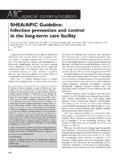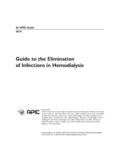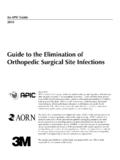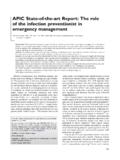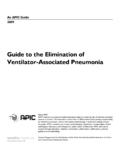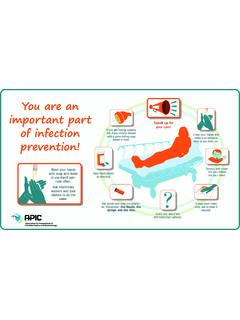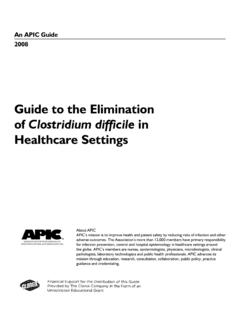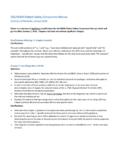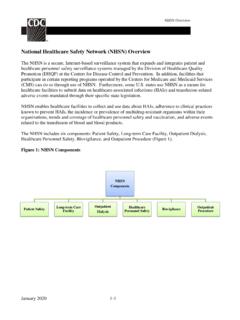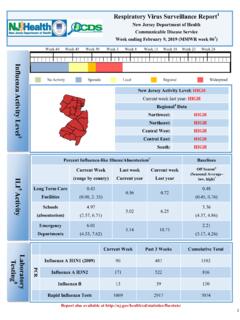Transcription of APIC - HICPAC Surveillance Definitions for Home Health ...
1 apic - HICPAC Surveillance Definitions for home Health Care and home Hospice Infections February 2008 Original Authors apic home Care Membership Section 2000 Freda C. Embry, RN, MSN, CIC, Chair 1998-1999 Libby F. Chinnes, RN, BSN, CIC, Chair 2000-2001 HICPAC Ad Hoc Committee Nancy B. Bjerke, RN, MPH, CIC HICPAC / apic Facilitator Russell Olmsted, MPH, CIC, HICPAC Dr. Kurt Stevenson, MPH, HICPAC Dr. Philip Smith, HICPAC Dr. Nalini Singh, MPH, HICPAC Freda C. Embry, RN, MSN, CIC, apic Libby F. Chinnes, RN, BSN, CIC, apic Mary Jane Ruppert, apic Emily Rhinehart, RN, MPH, CIC, CPHQ, AIG Consultants Mary McGoldrick, MS, RN, CRNI, home Care and Hospice Consultant Teresa Horan, MPH, NHSN Mary Andrus, BA, RN, CIC NHSN HICPAC Members 2006 and 2007 Dr. Patrick J. Brennan, Chair Vicki L. Brinsko, RN, BA Dr. Jeffrey Engel Dr.
2 Steven M. Gordon Lizzie J. Harrell, PhD Dr. David A. Pegues Carol O Boyle, PhD, RN Dennis M. Perrotta, PhD, CIC Harriett M. Pitt, RN, MS, CIC Dr. Keith M. Ramsey Dr. Nalini Singh, MPH Dr. Kurt Stevenson, MPH Dr. Philip W. Smith Lillian A. Burns, MPH Dr. E. Patchen Dellinger Yvette S. McCarter, PhD Denise M. Murphy, RN, MPH, CIC Russell N. Olmsted, MPH, CIC Barbara M. Soule, RN Reviewers Dr. William B. Baine, HICPAC AHRQ Roslyne Schulman, MHA, MBA, HICPAC AHA Joan C. Blanchard, RN, BSN, MSS, CNOR, CIC HICPAC AORN Rachel L. Stricof, MPH, HICPAC ACET Sandra Fitzler, RN, HICPAC AHCA The Association for Professionals in Infection Control and Epidemiology, Inc. ( apic ) home Care Membership Section published Draft Definitions for Surveillance of infections in home Health care in December 2000. (Embry FC, Chinnes LF. AJIC 2000;28:449-53) As a guidance resource for Infection Control Professionals (ICPs) working in the home Health care practice setting, these Definitions have been used for seven years.
3 apic has requested and received support from the Centers for Disease Prevention and Control s (CDC s) Healthcare Infection Control Practices Advisory Committee ( HICPAC ) to revisit the draft Definitions for Surveillance of infections in home Health care and to expand the application to include home hospice. HICPAC has agreed to support this final document for Surveillance purposes. A healthcare associated infection (HAI) is an infection that develops in a patient who is cared for in any setting in which healthcare is delivered ( , acute care hospital, chronic care facility, ambulatory clinic, dialysis center, surgicenter, home ) and is related to receiving Health care ( , was not incubating or present at the time healthcare was provided). In ambulatory and home settings, HAI applies to any infection that is associated with a medical or surgical intervention.
4 Since the geographic location of infection acquisition is often uncertain, the infection is considered to be healthcare associated, rather than healthcare acquired. (Siegel et al. Fed. Reg. 2004;69(113):99) HAI criteria for home Health care and home hospice are essential to the specific anatomical site Definitions for HAI. Thus, home care and home hospice healthcare associated infections (HAIs) are those infections that were neither present nor incubating at the time of initiation of care in the patient s place of residence. For those infections apic HICPAC Surveillance Definitions for home Health Care and home Hospice Infections February 2008 2 appearing in a patient within 48 hours of discharge from a healthcare facility, the infection(s) is reported back to the facility that discharged the patient prior to their home care services.
5 Background: An estimated million infections occur annually in approximately 8 million adult and pediatric home Health care patients in the US. (Manangan et al. EID 2002;8(3):233-236) The predominant risk factor for a HAI is the presence of a medical device ( , catheters). Additionally, 20% of home Health care patients require wound management. Patte and others identified an overall, single-day HAI point prevalence rate of among a group of patients in France receiving home care, using CDC Surveillance Definitions developed for acute care; the majority of these HAIs involved the urinary tract. (Patte R JHI 2005;59:148-51) A study of the incidence of complications associated with central venous catheters in over 50,000 patients receiving home infusion found an incidence of infections/1,000 catheter days and infections/1,000 catheter days associated with the local cannula site and bloodstream infection (BSI) respectively.
6 (Moureau N et al. JVIR 2002;13:1009-16) This incidence is similar to that reported by Gorski: infections/1,000 central venous catheter days; however, site Definitions used in this investigation differed from those used by Patte. (Gorski LA JIN 2004;27(2):104-11) Still, there are few studies of infectious outcomes among those receiving home care; and despite calls for validation and reproducibility of Definitions and methods for Surveillance , progress remains limited to date. (Manangan LP et al EID 2002;8:233-6) Therefore, a Surveillance system for the home Health care and hospice practice settings is essential to better describe the incidence and epidemiology of HAIs among those receiving home care services and hospice care. Several issues have precluded in-depth validation and study of reproducibility of the draft home Health care Definitions .
7 (Manangan LP EID 2002;8:233-6) First, a survey of several home care agencies found that just over half of 95 agencies supported a trained, designated ICP to oversee their HAI Surveillance program. (Manangan LP ICHE 2000;21:114 (abstr)) Second, patients may be served by more than one care agency and provider of care ( , home Health care personnel, dialysis staff, family caregiver, etc.), a circumstance that inhibits the capture of outcomes if patients receive care from a provider other than the initial agency. Third, specimen collection and convenient access to both clinical and laboratory data among those patients are often lacking in the home care setting. Finally, reporting, collation, and analysis of outcome indicators and processes may be limited and/or incomplete. Criteria for infection Definitions in acute care Health facilities usually include combinations of clinical findings and results of laboratory and other diagnostic tests.
8 Laboratory testing and radiological procedures are performed infrequently for hospice patients due to their limited life expectancy and patients in the home . For these home Health care and hospice patient populations, reliance is largely on clinical observations to assess changes in the patient s status, made by the patient s Health caregivers and providers, and is the basis for these Definitions . As a result, there is an introduction of subjectivity and variability in both observations and associated documentation, which must be acknowledged. Goals and Purpose of Surveillance : The goals, purpose and infrastructure of an effective Surveillance program have been previously described. (Lee TB et al. AJIC 1998;26:277-88; Friedman C et al. ICHE 1999;20:695-705; CDC. MMWR 2001;50(RR13); Lee TB et al. AJIC 2007;35:427-440) In brief, these remain as stated: to enhance the safety and quality of patient care provided, to reduce morbidity and mortality, and to improve Health regardless of the practice setting.
9 home Health care agencies and home hospices must establish HAI Definitions for the purpose of Surveillance before initiating a Surveillance program tailored to the patient receiving Health care in the home environment. Definitions should be consistently used in the collection, analysis, and reporting of infection data. Surveillance Definitions of infection are not intended to be used to make clinical decisions apic HICPAC Surveillance Definitions for home Health Care and home Hospice Infections February 2008 3 or determine treatments. Definitions developed for the purpose of Surveillance may be of limited value in an outbreak investigation as a specific case definition is usually required. The purpose of Surveillance in home Health and hospice care is to assess the safety and quality of patient care provided by establishing a baseline at each agency, to monitor trends within the agency, to use findings to improve care, and to prevent HAI and other complications.
10 Valid written Definitions enhance consistency, accuracy, and reproducibility of the Surveillance data; however, Definitions are only one piece of Surveillance . As has been learned within acute care practice settings, those who desire interfacility or, in this case, interagency comparison are advised to use caution when attempting to compare outcomes as there are a multitude of variables that can affect accuracy of indicators from one agency to the next. Until a standard set of HAI Definitions for home Health care and home hospice are finalized and implemented within a Surveillance program and Surveillance data analyzed, a lack of realistic incidence per site exists. A risk assessment of the population served and range of services provided should be a starting point to identify appropriate process and outcome indicators.
